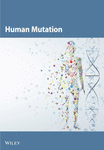Novel and recurrent mutations in the NF1 gene in Italian patients with neurofibromatosis type 1†‡
Communicated by Richard G.H. Cotton
Online Citation: Human Mutation, Mutation in Brief #716 (2004) Online http://www3.interscience.wiley.com/homepages/38515/pdf/mutation/716.pdf
Abstract
Neurofibromatosis type 1 (NF1) is one of the most common autosomal dominant disorders in humans, affecting 1 in 3500 individuals. NF1 is a fully penetrant exhibiting a mutation rate some 10-fold higher compared to most other disease genes. As a consequence, a high number of cases (up to 50%) are sporadic. Mutation detection is complex due to the large size of NF1 gene, the presence of pseudogenes and the great variety of lesions. In the present study we attempted to delineate the NF1 mutational spectrum in the Italian population reporting four-year experience with the direct analysis of the whole NF1 coding region in 110 unrelated subjects affected by NF1. For each patient, the whole coding sequence and all splice sites were studied for mutations, either by the protein truncation test (PTT), or, most often, by denaturing high performance liquid chromatography (DHPLC). Mutations were identified in 75 (68%) patients. Twenty-two mutations were found to be novel. The detection rate for the different methods was 7/18 (39%) for PTT, and 68/103 (66%) for DHPLC. The mutations were evenly distributed along the NF1 coding sequence. Thirty-two of the 75 unrelated NF1 patients in which germline mutations were identified (32/75, 43%) harbour 23 different recurrent mutations. Fifteen sequence variants likely to represent non-pathogenic polymorphisms were observed at the NF1 locus. Genotype-phenotype analysis was unable to detect any obvious correlation. © 2004 Wiley-Liss, Inc.




